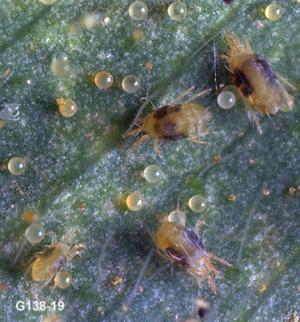|
TWOSPTTED SPIDER MITE MANAGEMENT |
|
CONTENTS Sampling and Action
Threshold |
Two spotted spider mite has become
progressively more important as a pest of mint throughout the Northwest. Probable reasons
may include: 1) development of resistance in populations of mites in mint fields which
have been repeatedly treated with miticides, 2) reduced use of flaming for spring rust
control, 3) changes in production practices or pesticide use patterns, causing increased
mortality of natural enemies, or 4) improved awareness of their pest status and the use of
proper sampling methods. Either fall plowing or spring flaming of mint contributes greatly
to the cultural control of mites in mint fields by reducing early season populations that
are initiated from overwintering female mites (Hollingsworth
and Berry, 1982b). Correct sampling procedures for spider mites
involve close observation of leaf samples taken from different areas in a field
(Hollingsworth, 1981; Hollingsworth and Berry, 1982b; Hollingsworth et al., 1984). Include
leaf samples from plants in areas that are high, excessively dry, and have had past
problems with mites, such as dusty areas or field margins. The use of a 10X or 15X hand
lens will enable growers to distinguish between spider mites and predator mites (see
below). By walking in a "Z" or "M" pattern in the field, randomly
collect stems and inspect the leaves from the bottom, middle and top of the stems for
mites (count adults, nymphs and eggs). Classify the leaves as "infested" or
"not infested" if the mites (adults and nymphs) number five or more. For each 30
acres, 14 individual field sites should be monitored for mites by examining a total of 45
leaves (15 leaves each from the bottom, middle, and top) from 15 randomly selected mint
stems per site. It also is important to count the number of predator mites on each leaf.
These natural predator mites help reduce spider mite populations below economic levels
through harvest. If predator mites are present, the field may not require immediate
treatment and should be rechecked at a later date. Treatment of spider mites is justified
if there are no predator mites and if 18 or more of the leaves in the 45-leaf sample taken
at each site are infested with five or more spider mites. It is also important to estimate
the number of spider mite eggs on the leaves, because their number will help predict an
emerging infestation. Hollingsworth et al. (1984), A Sampling Plan For Twospotted Spider
Mites in Mint, PNW 251, explains an effective system for monitoring infestations of spider
mites in mint. To convert the number of leaves with 5 or more mites to an estimate of the
mean mites per leaf, use the spider
mite sampling calculator. Spring flaming for rust control west of the Cascade Mountains in Oregon and Washington reduces the incidence of spider mites early in the growing season. This may result in fewer applications of miticides during the growing season (Hollingsworth and Berry, 1982a, 1982b). Fewer miticide applications will help delay the development of mite resistance, protect beneficial predators, and reduce production costs. BIOLOGICAL CONTROL Be sure to refer to additional information concerning biological control of spider mites (Berry et al. 1992, 1994). For detailed information on the use of predator mites to control twospotted spider mites in mint, see Morris 1998, Morris et al. 1996, and Morris et al. 1999). |

